Q&A November 24, 2022: 2nd Segment
QUESTION 9
SHOULD BOUGAINVILLEA BE PRUNED NOW? (STILL BLOOMING)
Question: I have a large potted bougainvillea that is too big for the house. In past winters I’ve just rolled it into the garage for freezing periods and then back out again, but it’s too gangly to do that now. Should I prune it now? It still has many blooms. Jack K., Brazos County.
Answer: Leave it out as long as you can. By then it will probably be losing interest in blooming and pruning won’t seem so harsh. You’re far enough south that the moves in and out probably aren’t as bothersome as they would be in the northern half of the state. Yes, prune it whenever you need to in order to save it, but trim off as little as possible.
QUESTION 10
WHAT NARROW TREE WOULD SHADE THIS SIDE OF THE HOUSE AND NOT INVADE A SEPTIC TANK IN THE SAME AREA?
Question: We are on 1.5 acres. We recently removed a 70-ft. bald cypress tree that had completely ruined a septic system that must now be replaced (cannot be moved). What smaller, narrower, non-invasive species could work there? Claudia E., Rockwall.
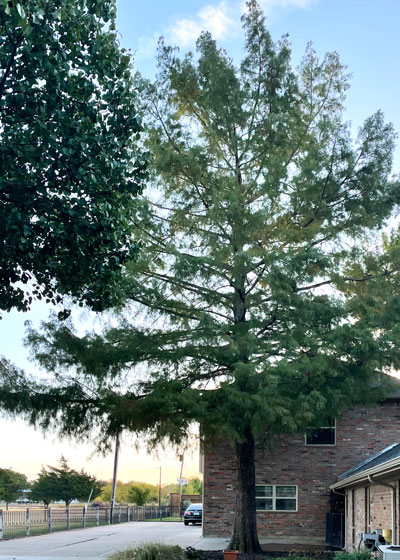
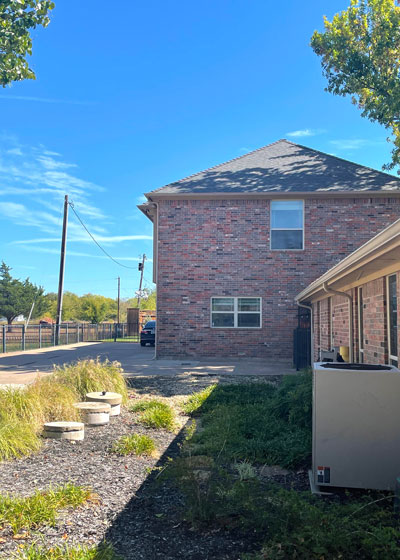
Answer: I’m trying to see how much space there is between the concrete and the old trunk’s location. For starters, no species has roots that are as invasive as bald cypress roots, so you’re going to be ahead no matter what you choose. You will also need a very tall tree to shade the second story, so tree-form hollies and average crape myrtles won’t cut the mustard.
Twilight crape myrtles grow quite tall, so one of those would work. Twilight is a deep purple variety. That would be nice against the reddish brick. Calloway’s on Galloway or Covingtons in Rowlett would be your best candidates to have one, but probably not until mid- to late spring. Avoid types like Natchez, Tuscarora and Muskogee. While they grow quite tall, they frequently freeze to the ground when it gets extremely cold.
Or you might consider Chinquapin oak. They are comparatively quick growers as oaks go. They’re oval in form initially, so most of its growth would be in height. You would want it 12-15 feet away from the septic equipment to avoid any problems with surface roots.
QUESTION 11
IS THERE A PRE-EMERGENT FOR FLOWERBEDS THAT WILL CONTROL NUTSEDGE AND OTHER WEEDS?
Question: Is there a pre-emergent product we can use for grassy and broadleafed weeds in our perennial and annual flowerbeds? We mulch and pull and dig nutsedge and other weeds, yet nothing seems to control them. Liz R., Hurst.
Answer: Nutsedge is a perennial weed, so pre-emergent weedkillers don’t work on it. You’ll want to use the Image product labeled for nutsedge control, but time for that won’t come around again until mid-May. You could use Gallery for prevention of broadleafed weeds, but only if they are annuals (come up from seeds each year). Timing would be, for Hurst, early March and early June for summer weeds and September 1 for cool-season weeds.
QUESTION 12
WHY ARE TIPS OF SAGO PALM LEAVES TURNING BROWN?
Question: I have a well-established sago palm in our yard. The tips of its leaves have turned brown. I cover it in an igloo-style greenhouse during the winter. Also, it has 3 pups on it. They need to be removed. What should I do? Deborah Q., Waco.
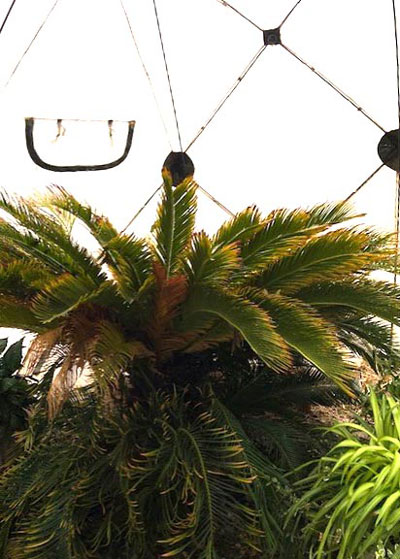
Answer: I can’t determine the exact cause of the browning from a photo. However, edge- and tip-burn is always going to be due to moisture stress. Either the plant got too dry during the summer, or it got too much fertilizer during the growing season and subsequently suffered root burn, then leaf scorch. It could have been too much sudden sunshine after the igloo greenhouse was removed and the plant couldn’t transport the water up quickly enough. I would start by flushing its soil thoroughly to get rid of mineral salt accumulations. Watch the new growth to see if it comes out free of the browning next spring. As for the pups, they can be cut apart from the mother plant once they have developed their own sets of roots. Use a large, very sharp knife to sever them. Plant them into pots filled with a loose, highly organic potting soil. Water them well and place them in a warm, bright spot.
QUESTION 13
WHAT CAN BE DONE TO MITIGATE VINCA DISEASES NEXT YEAR?
Question: We have red clay soil. We planted vinca flowers this year, but they got fusarium wilt. Besides fungicide, are there any cultural remedies to mitigate it next year? Mark R., Lamar Co.
Answer: The disease problem I see perhaps 99 percent of the time on vinca (annual periwinkles) is aerial stem blight/root rot brought on the fungus Phytophthora. It causes portions of a plant to shrivel and wilt. On close examination you’ll see a sunken gray lesion on the stem looking like a hot knife has been pressed against it. Soon another twig on the same plant is infected and within a week or two the entire plant is lost.
The disease is spread by splashing water, so irrigation must be done carefully, preferably at ground level instead of with sprinklers or sprays. Vinca plants thrive in the heat, so waiting until June to plant is to their benefit, plus it lets you miss the bulk of the splashing spring rains.
There is no fungicide that offers much help for Phytophthora, but the improved series named Cora XDR (extreme disease resistance) shows the best chance of beating the odds. Planting in large patio pots to ensure good drainage also helps.
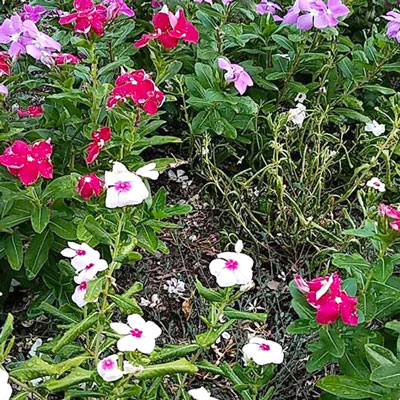
QUESTION 14
CAN I TRIM SHOOTS OFF MY COLOCASIA PLANTS?
Question: I have Colocasia esculenta growing in my flowerbeds. They send out these long shoots at the bottoms of the plants. Is it OK to cut these shoots off? Jean F., Scroggins.

Answer: I looked closely at your photo and all I saw were the petioles (the “stems” of the old leaves). They can certainly be trimmed off. However, it won’t be too many more days before the first freeze will kill all this growth back to the ground anyway. It would be fine to wait until that happens if you wish.
QUESTION 15
IS THIS A GOOD TIME TO TRANSPLANT TEXAS SAGE?
Question: Is this a good time to transplant our 4-ft. Texas sage? Pam M., Ellis Co.
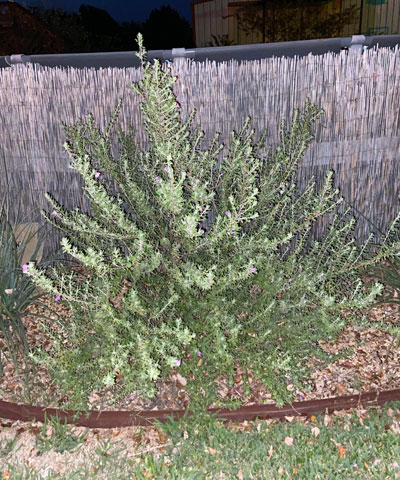
Answer: Unless there is a need to do so earlier, I would wait until early February. Texas sage plants are tender to winters in North Central Texas. Transplanting stimulates new growth, and you really don’t want new growth on the plants at this time. At a minimum, wait until the plant has been subjected to at least one hard freeze (26-27F). Best time of all, though, would be the first half of February. Prune it back by 30 to 40 percent after the move.
